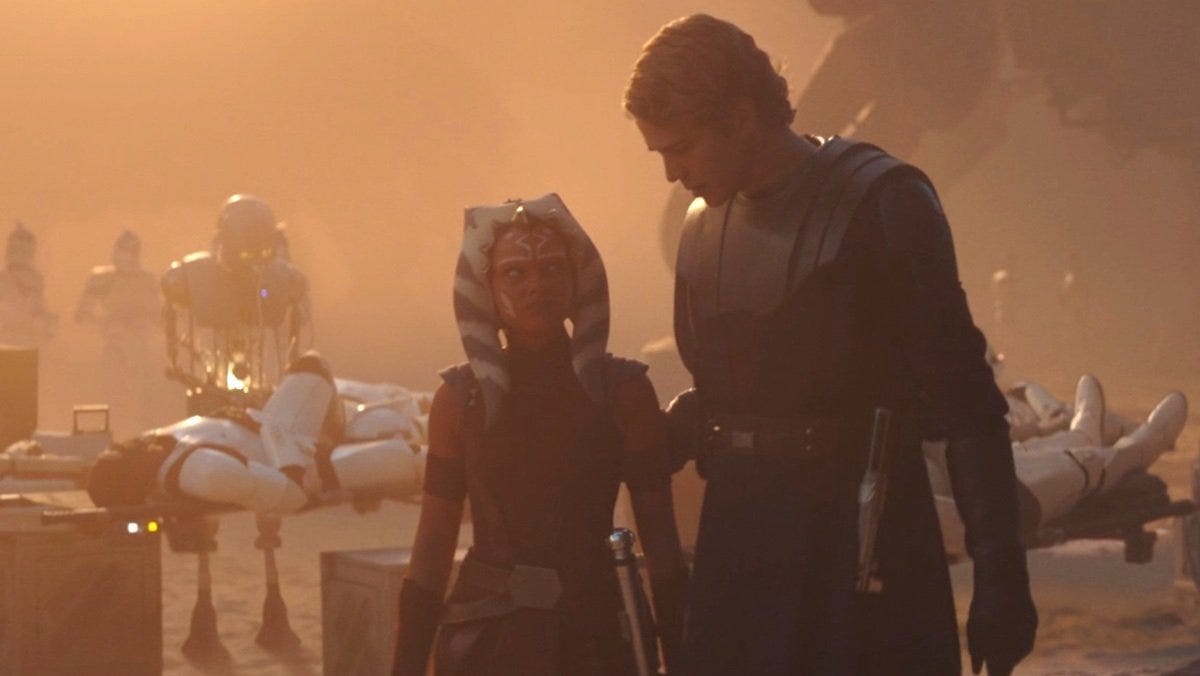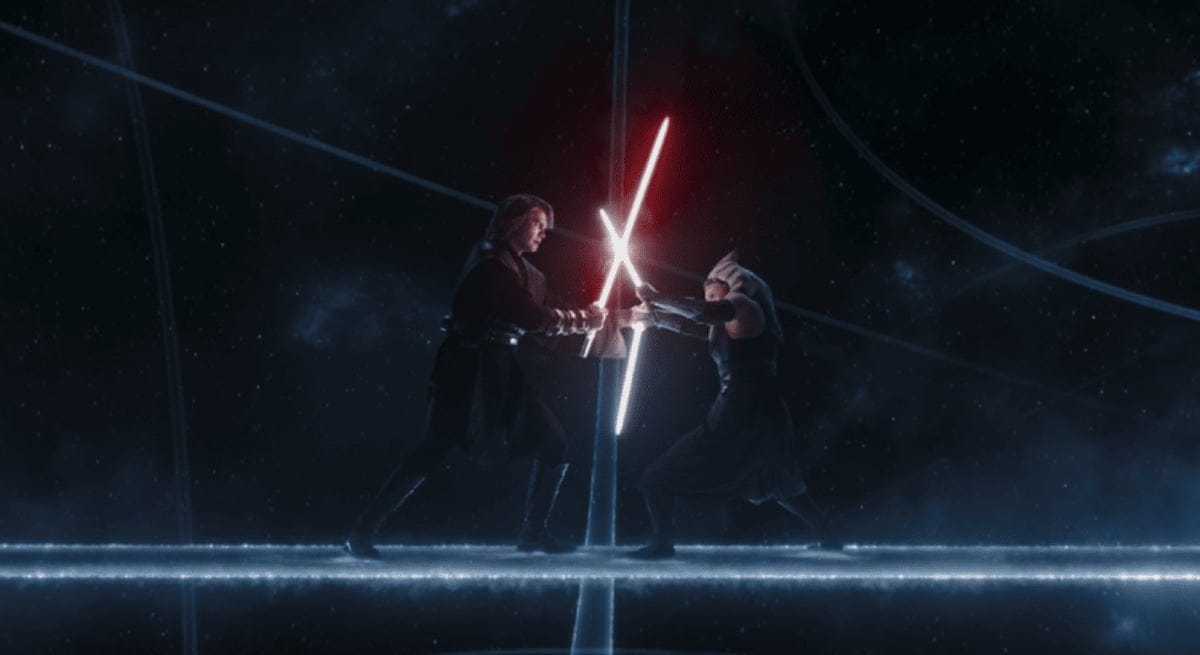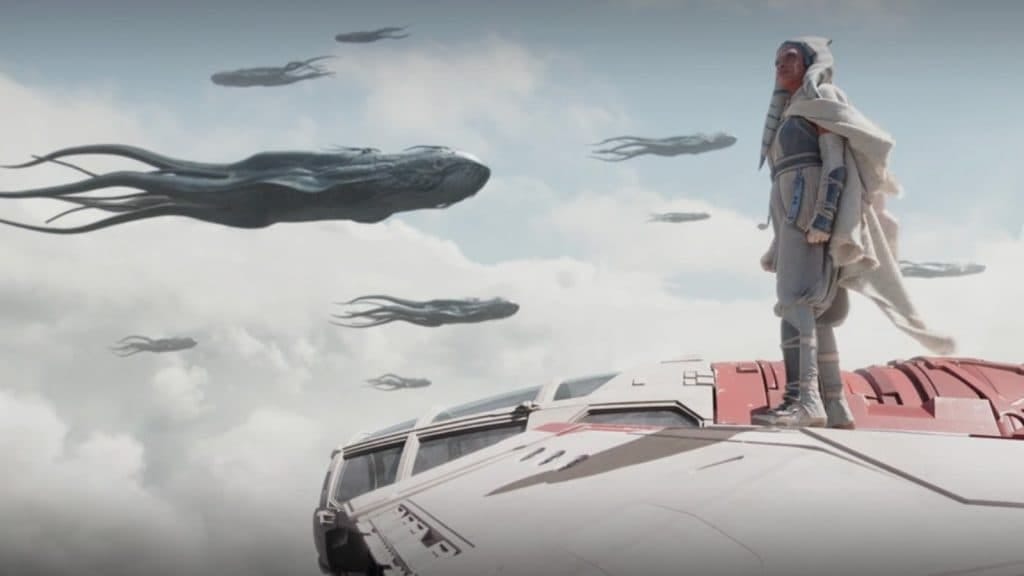Human Lens #118: Let's Talk About 'Shadow Warrior'
The fifth episode of the Ahsoka series pushes the story along while teaching the importance of letting the past go.
When I review a television series, I always wait until the end to give my full opinion on the story as a whole. I find that jumping the gun and honing in on an opinion before you see the full picture is asinine. However, every once in a while, series will showcase single episodes of television that are something special, bringing together storylines and revealing something to the audience that induces the overarching message unto us all — the hopes of that message sticking the landing in the second half bringing a sense of rejuvenation. In less definitive words, this is the climax, and we were treated to a great one earlier this week. The last time I wrote a ‘Let’s Talk About,’ it was for the Star Wars spinoff The Bad Batch, titled ‘The Outpost.’ That story served as the climax of its respective story, and another Star Wars series delivered earlier this week.
***Spoilers Ahead***

The fifth episode of Ahsoka, titled ‘Shadow Warrior,’ sees our title Jedi on the verge of death, stranded in the strange and elusive realm of the World Between Worlds that was first introduced in Star Wars: Rebels. With her, as revealed at the end of last weeks episode, is her former Master, Anakin Skywalker, who needs no introduction. But the man who plays him gets a well deserved reintroduction, as Hayden Christensen blends his own performance with that of Matt Lanter’s in the animated Clone Wars series to finally stand side by side with the Padawan he’s never, personally, shared screen time with.
The World Between Worlds doesn’t really have a rulebook, but it essentially serves as a bridge between reality and the cosmic force itself. Anakin, appearing as what is essentially a force ghost, states that he’s appearing to Ahsoka in order to help finish her training, offering her a choice of life or death. It’s less a physical choice and more of a call for Ahsoka to change her spiritual approach to life. Since leaving the Jedi Order during the Clone Wars, she has been haunted by what she was forced to become, and what ultimately lead to her own Master’s downfall to the dark side — a warrior.

Contrary to popular belief, and what the movies and games mostly show us, the Jedi are not meant for violence, being forced to twist their own teachings and skills into military leadership right at the point when Ahsoka became a Padawan learner. After our first lightsaber confrontation of the episode between Master and Apprentice, Ahsoka finds herself in her younger body at the first battle she shared with Anakin during the Clone Wars. Witnessing the death and suffering that the people of Ryloth and the clones are going through, she reminisces with her future perspective, through her younger form that’s holding the hand of an injured clone, saying “we lost so many.” Anakin tells her that he had to teach her what would help her to survive in the changing landscape of the galaxy. After everything she learned about her purpose growing up before the war, she couldn’t accept the direction the Order was going in.
After leaving the Order because of their misguided virtues and clouded judgement, the many losses of her clone brothers, and her failure to stand at her Master’s side to prevent his fate, Ahsoka has been on the run from all connection. She has taken the Jedi code literally, providing help during her appearances in Rebels sparingly, and failing to connect with Sabine during their first attempt at being a Master and Apprentice. With an empty ship and an old droid as company, Ahsoka has been letting her past define her for years in a self appointed exile that hasn’t helped the way she thought it would. Anakin’s choice of life or death is asking his Apprentice to fester in her failure or decide to move beyond her shackles.

Accepting the future and hoping for the best is so hard to do in a galaxy far far away, and the real world. Cynicism clouds all of our judgements, and our memories always linger on mistakes we’ve made before anything of merit. Yes, Ahsoka has made mistakes and even allowed hurtful ideologies to disguise themselves right in front of her, but lingering in those moments has kept her stagnant for decades now. To summarize the lesson Anakin teaches her, completing her training — go forward with what you have learned, and open yourself up to new experiences in a way that you feel is right. Don’t define everything with an outcome that hasn't transpired yet. Live.

Upon returning from her battle with death, Ahsoka has obviously changed, smiling more and showing affection and attention to those around her. As the episode comes to a close, Ahsoka and Huyang begin the journey to find Sabine and Ezra, yet the space whales (purrgil) that they’re using to get there aren’t completely reliable. While Huyang shows concern that the purrgil could take them anywhere, Ahsoka says the most important line of the episode, proving that her journey with Anakin was successful: “It’s better than going nowhere.”
‘Shadow Warrior’ could have simply been a fanfare heavy episode for Hayden Christensen’s return and nothing more, but Dave Filoni successfully wrote and directed an episode that brought that kind of fan service while furthering Ahsoka’s development and moving the overall plot forward. It was wonderful to see Hayden again and you could tell he was happy to be back, accepted by a fan base that grew up loving his movies and is finally getting a chance to show him. While this episode, and the series so far, are delving into the strange sci-fi elements that have been present within the multiple animated series, this is general audiences first foray into the strangeness of the expanded universe, beyond the films. While there may be an adjustment period for those that aren’t used to this sort of thing, they’ll catch on quickly as long as the events that transpire hold its characters and their personal journeys most dear. Star Wars is more than lightsabers and space action, it’s a universe, mirroring our own, that ultimately makes us better people. It’s episodes like this that remind us how important it is to live.




